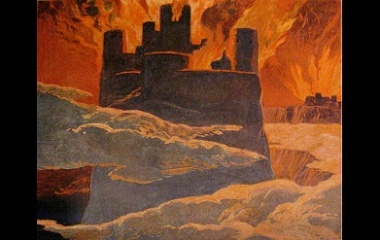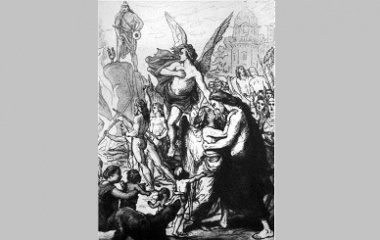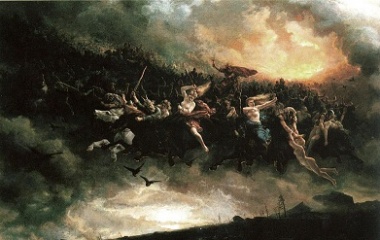Though the mighty immortal gods of Norse Mythology lived in a seemingly impenetrable fortress in the sky called Asgard, they were still prone to one lamentable weakness: a fear of invasion. Did they fear the chaos of war as an antithetical threat on the ultimate order their home embodied?
What Is Asgard?
The word Asgard comes from the Old Norse word Ásgarðr, meaning Enclosure of the Aesir. Asgard is one of the nine worlds in Norse Mythology, along with Niflheim, Muspelheim, Midgard, Jotunheim, Vanaheim, Alfheim, Svartalfheim, and Helheim. Asgard is the home of the Aesir, deities of one of two tribes of Norse gods. The other tribe, the Vanir, used to share Asgard but the two tribes fought a long, epic war over their differences and the Vanir were forced to leave Asgard. The two tribes did reach an eventual truce as they joined forces against their common enemy, the Giants.
Snorri Sturluson, author of the Prose Edda, wrote that Asgard was created by the gods after they created Jotunheim (Giantland), Midgard (Middle Earth or home of humanity), the seas, sky, clouds and the Earth. The home of the gods is said to be a giant fortress with walls reaching up into the clouds to protect them from their enemies, particularly the frost-giants.
Where is Asgard?
Asgard is situated in the sky upon the plains of Idavoll, where the gods met to discuss important matters. It was connected to Midgard by a rainbow bridge called Bifrost. The mythical place was invisible and inaccessible to mortal men.
Inside Asgard
The ruler of the gods, Odin, had his throne in Asgard, in a hall called Valaskjalf. His throne was called Hlidskjalf and it is believed that when Odin sat on Hlidskjalf, he could see the whole of heaven and Earth and everything that happened anywhere! A hall made of pure gold was also situated in the home of the gods. It was called Gladsheim and housed the thrones of Odin and the 12 highest gods. The goddesses’ hall was called the Vingolf or hall of friendship. The gods and goddesses would meet every day and discuss the fate of world at the Well of Urd (destiny), from which the Yggdrasil (the tree connecting the nine worlds) grew.
Asgard also housed Valhalla (the hall of the fallen). Odin granted access to the worthy dead, the majority of whom were esteemed warriors. Here, he feasted and celebrated with the battle heroes. Valhalla was easily recognizable by its rafters formed of spears, and use of shields as roof tiles. According to certain sources, the doors of Valhalla were so wide that 800 warriors could walk through at the same time! A vast river, the Thund, and a barred gate, Valgrind, protected the entrances of Valhalla.
Order and Chaos
Innangard and Utangard distinguish the ancient Germanic concepts of order and chaos. Innangard is civilized, orderly and law-abiding, while Utangard is wild, chaotic and anarchic. The concepts apply to both a geographical location and a mental plane, connected with one’s actions and thoughts. The home of the Giants, Jotunheim, is the best illustration of Utangard, as Asgard is the archetype of order or Innangard. The distinction between the two states is also evident in Germanic cosmology. Three of the nine worlds, Asgard, Midgard and Utgard (another version of the name Jotunheim), have the suffix –gard. Asgard and Midgard are Innangard worlds and constantly protecting themselves against Utgard, an Utangard world led by lawless giants. This affirms the close ties between the Germanic spiritual universe and the physical world.
Source
The Viking and Medieval ages, between 800 and 1400 AD, were the periods that provided the most significant historical and mythological literature written in the Old Norse language. In Iceland especially, the people continued to practice their traditional religion and preserve its history even after Christianity became their official religion in 1000 AD. Their perpetuation of pre-Christian Germanic traditions and writings is an invaluable source today. Three preeminent examples of these sources are:
The Poetic Edda
The Poetic Edda is a collection of poetry by Old Norse-speaking poets. This source provides the greatest insight into the mythology and is particularly in-depth. The Poetic Edda or Elder Edda contain two important poems: the Völuspá and the Grímnismál, which reflect on pre-Christian Norse mythology and cosmology.
The Prose Edda
In the 13th century, Icelandic poet, author, mythographer and historian, Snorri Sturluson, wrote the Prose Edda, an interpretation of traditional Icelandic poetry. Sources cite the Prose Edda as providing the greatest quantity of information of the Old Norse history. The author’s work does, however, contain certain claims which don’t align to the worldview and perhaps attempt to bring the old mythology in line with Christianity.
The Sagas
The sagas portray the lives of well-known Scandinavian, Icelandic and Germanic people from the 13th and 14th centuries, but do not refer in detail to pre-Christian religion. The Saga of the Ynglings, however, describes Norse deities and their actions in detail, though written in a way to rationalize mythology as a mere exaggeration of everyday historical accounts. In the Ynglings Saga, also authored by Sturluson, he asserts that Odin is demoted from the all-father to a sorcerer with the ability to shape-shift, blind his enemies and put his own troops in an invulnerable, trance-like state. On his mortal death, Odin is not sent to Asgard, but rather, Sturluson says, to Valhalla. He later changes Valhalla to heaven.
In Asgard, the gods decided on the fate of man each day anew. They could throw humanity into a state of Innangard or Utangard with a simple decision. Order and chaos needn’t be too far from each other, as seen in the modern concept expressed in the chaos theory, or butterfly effect. This is popularly understood as the ability to explain everything by understanding the small reasons or events that bring about an eventuality, or that everything happens for a reason, when in reality predictability is limited. The Aesir held humanity’s destiny in their hands and certainly loved to roll the dice!










